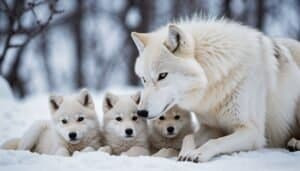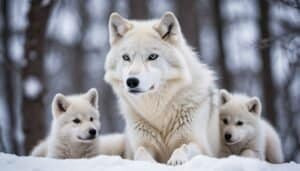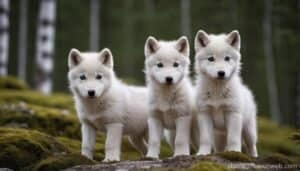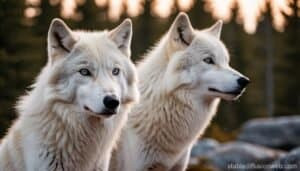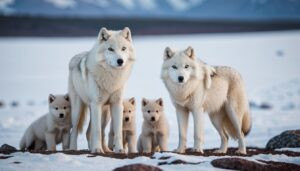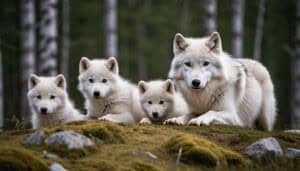Introduction
Understanding the reproductive cycles of Arctic wolves compared to other wolf species reveals fascinating insights into how these animals have adapted to their environments
This article explores the specific breeding seasons, environmental and behavioral influences, pup rearing practices, and the impact of external factors on reproductive success. By delving into these aspects, we can better appreciate the unique challenges and strategies Arctic wolves employ to ensure the survival of their species
Breeding Seasons and Reproductive Cycles of Arctic Wolves and Other Wolf Species
The reproductive cycles of Arctic wolves (Canis lupus arctos) present unique adaptations to their harsh environments, setting them apart from other wolf species
This section explores the specific breeding seasons, gestation periods, environmental factors, and the impact of climate and seasonal changes on their reproductive strategies
Specific Breeding Seasons
Arctic wolves typically breed during late winter, from February to April. This timing ensures that pups are born in May or June, allowing them to grow during the relatively mild Arctic summer
In contrast, gray wolves (Canis lupus) and other wolf species, such as the red wolf (Canis rufus), usually breed slightly earlier, from January to March. These differences align with the environmental conditions each species faces
The breeding season’s timing is crucial for pup survival. In the Arctic, having pups in early summer ensures that they have a few months of growth before the harsh winter returns. This period allows the pups to develop the necessary strength and skills to withstand the extreme cold
Comparison of Gestation Periods
The gestation period for Arctic wolves, like other wolves, is approximately 63 days. Despite the harsh conditions, this duration is consistent across wolf species. The timing of the birth is carefully synchronized with the availability of prey and the more favorable summer weather
This alignment is essential for the survival of both the mother and the pups
Gray wolves and red wolves also have a similar gestation period. However, the availability of resources and the milder climates they inhabit can lead to slight variations in the exact timing of births
For example, gray wolves in temperate regions may give birth as early as late April, while those in colder regions might synchronize more closely with the Arctic wolves’ schedule
Environmental Factors
The Arctic environment poses unique challenges that influence the reproductive cycles of Arctic wolves
Extreme cold, scarcity of prey, and long periods of darkness during winter significantly impact their breeding strategies. The limited availability of food means that Arctic wolves must carefully time their reproductive efforts to coincide with periods when prey is more accessible
In contrast, gray wolves and other species living in more temperate regions face different environmental pressures. While they still need to ensure the availability of prey, the less severe weather conditions provide a broader window for breeding and raising pups
This flexibility allows for variations in reproductive timing based on local environmental conditions
Climate and Seasonal Changes
Climate and seasonal changes play a crucial role in shaping the reproductive cycles of Arctic wolves
The brief Arctic summer provides a narrow window for pup growth and development. During this time, the abundance of prey, such as Arctic hares and lemmings, peaks, offering a vital food source for nursing mothers and growing pups
Seasonal changes also impact the availability of den sites. Arctic wolves often choose dens in areas with snow cover, providing insulation against the cold and protection from predators. The timing of snowmelt and the onset of winter influence the selection and preparation of these dens
Gray wolves, inhabiting diverse climates from forests to plains, face different seasonal challenges. In temperate regions, seasonal changes are less extreme, allowing for a more extended period of prey availability and denning opportunities
This variability results in a wider range of reproductive timings compared to the relatively strict schedule of Arctic wolves
Behavioral and Pack Dynamics in Reproductive Cycles
Arctic wolves exhibit unique behaviors and pack dynamics that influence their reproductive cycles. Understanding these aspects helps in comprehending how these wolves adapt to their harsh environment
This section delves into the mating rituals and pack dynamics during the breeding season
Mating Rituals
Mating rituals in Arctic wolves are intricate and play a crucial role in the reproductive success of the pack
Similar to other wolf species, Arctic wolves form monogamous pairs that last for life. The alpha male and female are typically the only breeding pair in the pack, ensuring that resources are concentrated on a single litter of pups
During the breeding season, the alpha pair engages in courtship behaviors that include playful interactions, grooming, and scent marking. These behaviors strengthen the bond between the pair and prepare them for mating
The timing of these rituals is synchronized with environmental cues, such as the lengthening days of late winter, which signal the approach of the breeding season
In comparison, gray wolves also exhibit monogamous pairings and similar courtship behaviors. However, the specifics of their mating rituals can vary based on environmental conditions and pack dynamics. For instance, packs in more densely populated areas may face competition from neighboring packs, influencing their mating strategies
Pack Dynamics During Breeding Season
Pack dynamics during the breeding season are critical for the reproductive success of Arctic wolves. The entire pack plays a supportive role in ensuring the survival of the pups. Subordinate members assist in hunting, protecting the den, and even regurgitating food for the nursing mother and pups
The alpha female, during her pregnancy and after giving birth, remains in or near the den. The rest of the pack ensures she has sufficient food and protection. This cooperative behavior is essential in the harsh Arctic environment, where the survival of the pack depends on the successful rearing of the next generation
Gray wolves exhibit similar pack dynamics, with the alpha pair receiving support from subordinate members
However, the structure and size of gray wolf packs can vary more widely, affecting the distribution of responsibilities. In larger packs, there might be more individuals contributing to pup care, while in smaller packs, the burden falls more heavily on fewer members
The division of labor within the pack is a significant factor in the survival of wolf pups. In both Arctic and gray wolves, the communal effort ensures that the pups receive adequate care and nutrition. The supportive role of subordinate members highlights the importance of pack cohesion and cooperation in wolf reproductive strategies
Pup Rearing, Survival Rates, and Influencing Factors
Pup rearing is a critical phase in the life cycle of wolves, with distinct differences observed between Arctic wolves and other wolf species. This section examines the various aspects of pup rearing practices, survival rates, and the factors that influence these outcomes
Differences in Pup Rearing Practices
Arctic wolves exhibit several unique pup-rearing practices adapted to their extreme environment. After giving birth in late spring or early summer, the alpha female stays in or near the den to care for the pups
The den, often a cave or a burrow dug into the permafrost, provides protection from predators and harsh weather. The rest of the pack members play a vital role in hunting and bringing food back to the den
Pups are born blind and deaf, weighing less than a pound each. They rely entirely on their mother and the pack for survival during the first few weeks of life. By three weeks of age, their eyes open, and they begin to explore their immediate surroundings
At this stage, the pack’s involvement becomes even more critical, with all members contributing to feeding and protecting the young
In contrast, gray wolves also use dens for birthing and pup rearing, but their dens are typically in forested or rocky areas, providing natural shelters. The size and structure of the pack can influence pup-rearing practices
In larger packs, more adults can assist in caring for the pups, while in smaller packs, the responsibilities are shared among fewer members
Survival Rates and Influencing Factors
The survival rates of Arctic wolf pups are influenced by several factors, including environmental conditions, prey availability, and pack dynamics
In the harsh Arctic environment, the survival rate of pups can be lower compared to other regions. Studies indicate that approximately 30-50% of Arctic wolf pups survive their first year, depending on the severity of weather conditions and the availability of food
One significant factor affecting pup survival is the availability of prey. During the short Arctic summer, an abundance of prey such as Arctic hares and lemmings can lead to higher pup survival rates
Conversely, harsh winters with scarce prey can result in higher pup mortality. The pack’s hunting efficiency and ability to provide for the young play crucial roles in determining the pups’ chances of survival
Gray wolf pups generally have higher survival rates, often around 50-70%, due to more stable environmental conditions and a wider variety of prey
However, these rates can vary significantly based on local factors, such as human interference, disease, and inter-pack competition. In regions where prey is abundant and stable, gray wolf pups have a better chance of surviving to adulthood
Prey Availability
The availability of prey is a critical determinant of reproductive success for both Arctic and gray wolves. In the Arctic, the seasonal abundance of prey like caribou, muskoxen, and smaller mammals directly impacts the wolves’ ability to nourish their young. The short summer months are a time of intense hunting activity, as the pack needs to build up reserves for the winter and ensure the pups are well-fed
In temperate regions where gray wolves reside, prey availability is generally more consistent throughout the year. Species such as deer, elk, and smaller mammals provide a steady food source
However, changes in prey populations due to factors like overhunting, habitat loss, and climate change can still significantly impact wolf reproduction and pup survival
Human Activity and Its Effects
Human activity is another crucial factor influencing the reproductive success of wolves
In the Arctic, human impact is relatively limited due to the remoteness of the habitat. However, increasing climate change and industrial activities, such as oil exploration, pose growing threats to Arctic wolves by disrupting their natural habitat and prey availability
Gray wolves are more directly affected by human activities, including habitat encroachment, hunting, and conflict with livestock farmers. Conservation efforts and legal protections have been implemented in many regions to mitigate these impacts and support wolf populations
The success of these measures varies, with some populations recovering well while others continue to face significant challenges
Adaptations and Health Factors in Reproductive Success
Understanding the adaptations and health factors that influence the reproductive success of Arctic wolves and other wolf species provides deeper insights into their survival strategies
This section explores the nutritional requirements, disease and parasites, and specific adaptations that help Arctic wolves thrive in their extreme environment
Nutritional Requirements
The nutritional requirements of pregnant and nursing Arctic wolves are critical for the health and survival of their pups. During pregnancy, the alpha female’s diet needs to be rich in protein and fat to support fetal development and her increased energy needs
After giving birth, her nutritional demands rise even further as she produces milk for her pups. The rest of the pack plays a vital role in meeting these nutritional needs by providing a steady supply of food
Arctic wolves primarily hunt large prey such as caribou and muskoxen, which provide the necessary nutrients. The abundance of these prey species during the summer months is crucial for the nutritional well-being of the pack, especially the nursing mother and her pups
Gray wolves, similarly, require a protein-rich diet to support reproduction. Their diverse diet includes deer, elk, moose, and smaller mammals, offering a varied and consistent source of nutrition. The availability and abundance of prey in their habitat directly impact the reproductive success of gray wolves, as adequate nutrition is essential for both the mother and the developing pups
Disease and Parasites
Disease and parasites pose significant threats to the reproductive success of both Arctic and gray wolves
Arctic wolves, living in relatively isolated and colder environments, have lower exposure to many diseases common in more temperate regions. However, they are still susceptible to parasites such as lice, ticks, and intestinal worms, which can affect their health and the health of their pups
Diseases like canine distemper, rabies, and parvovirus can have devastating effects on wolf populations. Arctic wolves are somewhat protected by their remote habitat, but an outbreak can still occur, especially if they come into contact with domestic dogs or other wildlife carriers
Gray wolves face a higher risk of disease due to their closer proximity to human populations and domestic animals. Rabies, distemper, and mange are significant threats, often leading to high mortality rates in infected populations
Additionally, gray wolves are more likely to encounter other packs, increasing the spread of infectious diseases
Adaptations to Harsh Environments
Arctic wolves have developed several adaptations to survive and reproduce in their extreme environment
Their thick, insulating fur provides protection against the severe cold, while their smaller size compared to other wolf species reduces heat loss. Arctic wolves also have a higher fat reserve, which helps them endure periods of food scarcity during the long winter months
Behavioral adaptations are equally important. Arctic wolves are highly nomadic, often traveling great distances in search of prey. This mobility ensures that they can find sufficient food to support their reproductive needs, even in the sparse Arctic landscape. Their ability to dig and maintain dens in the permafrost offers protection for their young against the elements and predators
Gray wolves, although not as specialized as Arctic wolves, exhibit their own adaptations to diverse environments. Their larger size and strength are advantageous for hunting large prey in forests, plains, and mountainous regions. Gray wolves also display remarkable adaptability in their diet and hunting strategies, allowing them to thrive in various habitats
The reproductive success of both Arctic and gray wolves depends on these physical and behavioral adaptations. The ability to find and secure adequate nutrition, avoid disease, and protect their young from harsh environmental conditions is essential for their survival
Conclusion
Understanding the reproductive cycles of Arctic wolves in comparison to other wolf species offers a fascinating glimpse into the adaptability and resilience of these remarkable animals
Arctic wolves have evolved unique strategies to thrive in the harsh conditions of their environment, with specific breeding seasons, gestation periods, and pup-rearing practices tailored to the extreme Arctic climate. Their reproductive success is heavily influenced by environmental factors, climate changes, and the availability of prey
In contrast, gray wolves and other wolf species exhibit more varied reproductive behaviors and timing due to their diverse habitats, ranging from forests to plains. These wolves face different challenges, including human activity and a wider array of diseases and parasites, which also shape their reproductive strategies
Both Arctic and gray wolves demonstrate remarkable cooperation within their packs, with all members contributing to the care and protection of the young. This social structure is crucial for ensuring the survival and growth of wolf populations
By examining the differences and similarities in the reproductive cycles of Arctic wolves and other wolf species, we gain a deeper appreciation for the adaptive capabilities of these predators. Their ability to adjust their reproductive strategies to the demands of their environments is a testament to the complex interplay between biology, ecology, and behavior in the natural world


